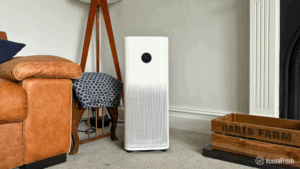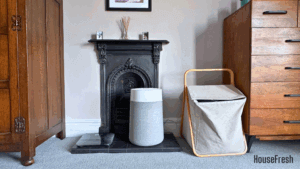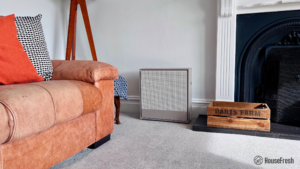We have already built and tested two DIY units at HouseFresh, the Corsi-Rosenthal box and the more basic DIY Air purifier. We were impressed by their air cleaning performance and straightforwardness to build. So, when I saw CR Box creator Jim Rosenthal’s tweet on the Nukit Tempest, I knew we had to give the Tempest a try.
Good review of the Nukit Tempest by @joeyfox85 here:https://t.co/0hB7IXu7f2
— Jim Rosenthal (@JimRosenthal4) December 30, 2023
I plan on buying one when the new stock is available. For those who support @NukitToBeSure, I would suggest you do the same.
I am a big fan of the CR box as it is incredibly reliable and can be built with just a few readily available components. However, it doesn’t come without its downsides: the fan is noisy, the box itself takes up a lot of space, and the build is not as robust.
After some discussion on X (formerly Twitter) on how these setbacks could be improved, PC fans were suggested as a suitable alternative for the bigger, louder box fan. It was Zack Deis who designed the first PC Fan Corsi-Rosenthal Box before donating his design so that the Nukit Tempest could be developed.
The Tempest is produced by Nukit, a Shenzhen-based startup on a mission to produce high-quality products at a fair price backed by third-party testing and supported by honest marketing and excellent customer service. Nukit has developed a small selection of products and is well known for the Nukit Torch Far-UVC Lights, which are increasingly popular online. They are always working to improve their products, and if you follow them on X, you will quickly learn that they are not shy when it comes to sharing the behind-the-scenes of their work, including new products they are developing right now.
When purchasing the Nukit Tempest kit, you get all the parts required to build the frame for $179.95. However, you still need to buy the MERV filters, DC power supply and PC fans (with fan guards, if you want them) — all of which are transparently listed on The Cyber-Night Market, which is the online store were you can buy Nukit products. We estimate a total cost of $300 to get all the items.
As always, we bought the Nukit Tempest kit and the parts with our own money to ensure we have the freedom to say what we really think after conducting the same performance tests we run on every air purifier we review.
That was a long intro, so I hope you’re still with me. Let’s jump into the review.
The lowdown on the Nukit Tempest

“I am super impressed by the Nukit Tempest. This new type of air purifier uses PC fans to offer great air cleaning power without high levels of sound. While this is the first generation, I’m super excited to see where this new approach to air purifiers takes us.
Be aware that this is a kit and does need some time and effort to build, but those who do will have a great air purifier that is also incredibly quiet.”
Before jumping into my full review, I have distilled the key strengths and weaknesses of the Tempest into pros and cons below:
What we really like
What we think could be better
| HouseFresh rating: | ★★★★☆ |
| Time to clean our 728 cubic feet test room (with the device running at top speed): | Without fan grills: 31 minutes With mesh fan grills: 43 minutes |
| Air filtration technology: | MERV 13 |
| Recommended room size (4.8 air changes per hour): | 385 sq. ft. (estimated) |
| Clean air delivery rate (CADR): | 247 CFM (estimated by @VentiloAngel) |
| Dimensions (in inches / in cm): | 21.25L x 20.25W x 9.6H inches (54L x 51.5W x 24.2H cm) |
| Weight (in pounds / in kg): | 14.7lbs (6.65 kg) |
| Filter life: | 12 months |
| Noise level in decibels (measured from 3 ft. away with a sound level meter): | 41.8 dB |
| Electricity consumption in watts (recorded with an electricity usage monitor): | 8.8 watts |
| Estimated running cost (electricity consumption + official filter replacement): | $50.11 per year |
| Cost per CADR cfm (based on dust CFM as reported by AHAM): | $1.20 |
| Country of manufacture: | China |
The best Tempest feature: Quiet yet powerful
You’ll barely notice it’s running thanks to the PC cooling fans — and it can still effectively cover rooms up to 385 sq. ft.

The Nukit Tempest not only looks cool but it also offers excellent performance with cleaning power comparable to many medium-to-large air purifiers we have tested.
Yet, despite its capacity to draw in considerable amounts of air through its filters, the Tempest runs far quieter than most.
But you don’t need to take my word for it. Check out the chart below comparing the max sound levels VS air cleaning speed of the Tempest against various popular air purifiers:
A PC case-inspired design that fits two large MERV filters and six fans
Assembling the Tempest is not particularly easy, but the end result is a cool-looking device with a gamer vibe.

The Nukit Tempest looks nothing like a regular air purifier. In fact, if you walked into a room with a Tempest, you are more likely to think it’s a desktop computer than a DIY air cleaner. Similarly to PC building, the appearance of your Tempest will vary slightly depending on the items you choose to assemble it.

It has six PC cooling fans on top and six more on one of the sides. As I have small children at home, I decided to also get 140mm mesh guards, which will protect the fans from dust but, most importantly, keep little fingers out of the way. However, it’s worth mentioning that the mesh grill restricted airflow, thus affecting the performance of the Tempest but I will tell you more about this further down the review.

Another important point to consider with my kids in mind: the metal is sturdy yet smooth, and it has no sharp edges or imperfections that could cut you while moving it from room to room. Speaking of which, it was great to see all the clever little design details that improve usability, such as the two handles at the top.

The Tempest comes with wire mesh side grills to guard the filters, making the device more resistant than other DIY air purifiers, including the CR Box. Plus, it conceals a bit the fact that it is an air purifier, avoiding the attention-grabbing white filters to be the center of attention.

Speaking of the Corsi-Rosenthal Box, I took a photo of the Tempest next to my CR Box to show you just how small and stylish the Tempest looks next to the bulky cube.

As you can see, the footprint of the Nukit Tempest is much smaller, making it a great choice for spaces where the CR Box couldn’t quite fit. It is also super lightweight, weighing no more than 14.7lbs.

Another thing worth mentioning is that the Tempest does not have a control panel. It is either plugged in and running, or unplugged. That said, you could buy a power supply with an on-off switch.

The Tempest was created with homes AND public spaces (such as schools and businesses) in mind, where air purifiers should be running 24/7 but are often not. This is the quietest unit I’ve tested able to clean the air effectively — for example, the Core Mini is super quiet, but it won’t be useful in most rooms.
Another example of quiet power is the Smart Air Blast Mini. I took a photo of both devices next to each other so you can see how they compare to one another in terms of size:

The Tempest kit comes with four metal panels, screws, a cardboard tube containing the side grills, four square, self-adhesive feet and 3mm rubber hole plugs, a 19mm rubber plug, a PWM connector, a 12v DC power connector AND zip-ties.
What you will need that’s not included is the following:
| ITEM | RECOMMENDED | WHAT WE BOUGHT |
|---|---|---|
| 6 x PC cooling fans | Arctic P14 | Amazon |
| 6 x Fan guards | 140mm mesh or metal | Amazon |
| 1 x DC power supply | 12v, 2A with 5.5x2.1mm barrel connector | Amazon |
| 2 x Filters | MERV 13 filters, 20x20x2 inch | Amazon |
While assembling the Tempest might seem a tad daunting for those not so comfortable with their DIY skills, there’s a thorough step-by-step guide on The Cyber Night-Market website with photos and detailed instructions. You can also watch my video:
All pieces, screws and cables come in separate bags to make assembling easier. It is kind of building a huge Lego –– a fun STEM project to be sure.
Two 20x20x2″ MERV filters protected by side grills
The Tempest is proof that you don’t actually need HEPA to achieve exceedingly good air filtration results.

That’s right: HEPA is not the failsafe many manufacturers want us to believe.
Certified HEPA filters are considered an assurance for many for their single-pass filtration efficiency, or in simpler terms, the capacity of a filter to trap particles in just one pass of air. The thicker the filter (HEPA 12, 13 and even 14), the more particles it can catch on the fibers in a single pass.
On their part, MERV filters have a lower single-pass filtration rate compared to HEPA filters. But air purifiers are designed to run continuously, circulating air and trapping particles on the filters in every cycle. As David Elfstrom, an engineer who has shed light on many key discussions related to indoor air pollution, puts it:
To recap, for in-room air cleaners, HEPA *IS NOT NEEDED*. What matters is the combination of filtration, fit, and airflow, to maximize the Clean Air Delivery Rate for a target particle type and size, verified by an independent laboratory test to an industry standard. /7
— David Elfstrom (@DavidElfstrom) February 23, 2024
So, with no real need for HEPA, the Nukit Tempest uses affordable and readily available MERV 13 filters just like the Corsi-Rosenthal Box and the simpler DIY air purifiers.
As MERV filters are less dense than HEPA, they allow for increased airflow. That means that they can move a lot more air than units with HEPA or HEPA-type filters, capturing more particles from the air.

The Nukit Tempest hasn’t been sent to the Association of Home Appliance Manufacturers for a CADR test, but that doesn’t mean that it’s not been tested by third-parties. David Elfstom estimated a CADR of 280 CFM and Nathalie Roussay (known as L’Évangéliste de la Ventilation on X) estimated 247 CFM – all of these using the Artic P14 fans, which are the same we’ve used in our own Tempest.
I will go deeper into air cleaning performance comparisons in the next section but, with these numbers, the Nukit Tempest and its MERV 13 filters could offer similar performance than air purifiers such as the Blueair Blue Pure 311+ and the Alen BreatheSmart 45i – both good, reliable units much liked by many users.
It’s worth noting that replacing the filters in your Tempest will be much easier than disassembling your CR Box and other DIY units before you can rebuild them with the new ones. With the Tempest, you just have to unscrew the sides, remove the old filters, place the new filters and screw them back.
If you buy MERV filters in bulk, make sure each one is sealed separately or at least in twos. You don’t want the filters in contact with the air before use, or they will start accumulating particulates as they are stored in a cupboard.
The Nukit Tempest cleared our test room in 31 minutes
The Tempest has the best performance-to-noise ratios across all 70+ air purifiers we have tested, and the six PC cooler fans have a lot to do with that.

To assess the real-world performance of the Nukit Tempest, we run the same tests we perform on all the air purifiers we review, including particle removal speed, noise output and energy usage.
For the speed test, we filled our 728 sq. ft. test room with incense smoke and used our two PurpleAir sensors (the Touch and the Zen) to monitor how long the Tempest took to clean the air, bringing the PM1 levels to zero.
As you will see on the chart above, it took the Nukit Tempest 31 minutes to complete our particle removal test.
This number changes when we add the mesh guards on top of the PC fans. I wasn’t expecting such a big difference, but it turned out that the mesh guards added 12 minutes to the test:
| Without fan grills | With mesh fan grills | |
|---|---|---|
| Nukit Tempest | 31 minutes | 43 minutes |
This is something to consider when building your Nukit Tempest. We haven’t tested it using wire fan grills, but I imagine it will be better than the mesh grill as, clearly, the ultrafine nylon restricts airflow:

A reader shared this report on the effects of different grill patterns on fan performance. It shows that the mesh grill does, in fact, restrict airflow. The report also shows that opting for a wire grill can achieve performance results nearly as good as running your Tempest without a grill.
Air cleaning performance, compared
With an average estimated CADR of 247 CFM, the Nukit Tempest’s cleaning speed definitely met our expectations.
Compared with units that boast similar CADR, the Tempest sits in the middle: the Blueair Blue Pure 311+ (250 CFM) was 10 minutes faster, but it outpaced the $428 Alen BreatheSmart 45i (207 CFM) by three minutes.
There is also a six-minute difference with the Corsi-Rosenthal Box (estimated 274 CFM). I cannot deny that I’m still a huge fan of the CR Box; it is such a practical solution for so many people and different contexts. However, if we factor in the noise output of the two, the CR Box’s speedyness becomes somewhat relative.
Let’s see how the Tempest performed noise-wise.
Noise levels, compared
This is one of the Nukit Tempest’s highlights: how quiet it runs. To measure the noise output, we used a commercial sound meter to record sound levels in dB(A) emitted by the Tempest from 3 ft. away.
As we saw in the first section, the Tempest has only one speed. When running, it emits 41.8 dB(A) of noise, which is equivalent to the (almost imperceptible) noise of a suburban area at night.
The chart below shows how the Tempest compares to other air purifiers.
If we focus on the lowest fan speeds, the Tempest might not be the quietest unit, but it is not the loudest, either. However, the comparison changes completely when we look at the top speed values: no purifier runs as quietly as the Tempest.
We were so impressed with these results that we decided to push our tests further. So, we compared the Tempest’s performance (speed and sound) versus some of the best units we tested but running at a similar sound level (in most cases, in Speed 2). Here’s what we found out:
| AIR PURIFIER MODEL | SOUND LEVEL AT TOP SPEED (dBA) | TIME TO CLEAN OUR TEST ROOM | PRICE |
|---|---|---|---|
| Levoit Vital 200S - Speed 2 | 42.5 dB(A) | 40 minutes | $189.99 |
| Winix 5300-2 - Speed 2 without ionizer | 42.5 dB(A) | 43 minutes | $199.99 |
| Taotronics AP-003 - Speed 2 | 42.8 dB(A) | 39 minutes | $99.99 |
| Nukit Tempest | 41.8 dB(A) | 31 minutes | $179.95 (plus parts) |
| Air Doctor 3000 - Speed 1 | 40.2 dB(A) | 43 minutes | $519.00 |
When noise output is the primary variable, the Nukit Tempest air cleaning performance amply outperforms all others.
I mean it when I say you will often forget the unit is running in the background. But still, don’t take my word for it; listen to the Tempest running for yourself:
The cost to run a Nukit Tempest: $50.11 per year
1. Electricity costs = $9.25 per year
When choosing an air purifier, long-term costs are worth considering, especially with rising electricity prices worldwide. So, as part of all our reviews, we measure electricity consumption using an energy meter.

The PC fans in the Nukit Tempest mean less noise and less energy usage. In our testing, the Tempest pulled a mere 8.8 watts. Running it 24/7 uninterruptedly would add up to less than $10 a year to your electricity bill.
As a reference, the Blueair Blue Pure 411 has an energy usage of 10 watts at top speed, and it was featured among the 2024 most efficient air purifiers at Energy Star. However, the Blue Pure 411 needed over an hour to remove all PM1 pollutants from our 728 sq. ft. room.
As with noise levels, the energy consumption of the Nukit Tempest matches the same figures you can expect from some of my favorite air purifiers when running at low fan speeds. The problem is that low fan speeds mean slower air cleaning performance, so when comparing these great devices against the Tempest, we see the Tempest win again:
| AIR PURIFIER MODEL | ENERGY CONSUMPTION AT TOP SPEED (watts) | TIME TO CLEAN OUR TEST ROOM |
|---|---|---|
| Air Doctor 3000 - Speed 1 | 9.6 watts | 43 minutes |
| Nukit Tempest | 8.8 watts | 31 minutes |
| Taotronics AP-003 - Speed 2 | 10.5 watts | 39 minutes |
| Levoit Vital 200S - Speed 2 | 8.0 watts | 40 minutes |
| Winix 5300-2 - Speed 2 without ionizer | 6.7 watts | 43 minutes |
The performance-to-energy usage ratio of the Nukit Tempest is just incredible.
2. Filter costs = $40.86 per year
Filter costs are the second ongoing expense to factor in. With store-bought units, you can choose between original, branded filters (which tend to be expensive) or generic ones (for which there’s not always enough information online).
The Nukit Tempest uses standard, non-proprietary 20x20x2 MERV 13 filters. Availability may vary depending on your location, but in the U.S., there are plenty of options at a varied range of prices.
We used Filterbuy’s set of two for a little over $40. Considering filters need to be replaced about every 12 months, the Tempest has one of the lowest long-term costs we’ve seen in the industry: around $50 a year.
There are simply too many reasons to love this device.
| AIR PURIFIER MODEL | ESTIMATED ELECTRICITY COST (per year) | FILTER REPLACEMENT COST (per year) | YEARLY MAINTENANCE COST |
|---|---|---|---|
| Coway Airmega 150 | $48.12 | $49.99 | $98.11 |
| Smart Air S | $41.00 | $73.98 | $114.98 |
| Levoit Vital 200S | $67.95 | $59.99 | $127.94 |
| Winix 5500-2 | $81.54 | $79.99 | $161.53 |
| Nukit Tempest | $9.25 | $40.86 | $50.11 |
| Mila | $58.45 | $150 | $208.45 |
Bottom line: Is the Nukit Tempest worth it?
The short answer: yes, but be aware that building it might be tricky if you’re not comfortable with cables and tiny parts
The Nukit Tempest has definitely impressed us with its clear advantages over shop-bought devices: it is super quiet, cleans the air pretty fast, can cover large spaces (385 sq. ft.), and its long-term running costs are as low as they get.
One of my favorite things about it is the environmentally conscious buy-it-for-life concept that defies a whole industry of devices with built-in planned obsolescence. Say the PC fans get old and start malfunctioning; you can replace those, and that’s it. The same applies if you want to upgrade the PC fans for newer, quieter ones or if you want to add an on/off switch or Nukit’s own power loss alarm. Most components in your Nukit Tempest could be swapped, upgraded and fixed at home. Besides, with standard MERV filters, you are not tied to any brand.

But I get it. Sometimes a ready-to-use solution is all you want or need, and that’s understandable. There are plenty of great store-bought air purifiers that will do a fine job. But if you are at all curious about the use of PC fans or fancy a STEM project you can carry out with your kids, then I strongly suggest giving the Nukit Tempest a try.
You won’t just get an amazing air purifier; you’ll also be supporting a worthwhile project with a genuine interest in indoor air quality that is affordable and powered by honest marketing — two things that the world really needs.
I’m currently testing other PC fan DIY air purifiers (the Luggable by Clean Air Kits, Adam Wong’s AirFanta 3 Pro and the NorthBox Systems’ 6XL), so make sure to subscribe to our YouTube channel to watch my review without having to wait for it to be published on our site.
If you want to take the DIY spirit further, the instructions to build the Nukit Open Air Purifier’s enclosure are available on GitHub (there’s even an app).
SOURCES
We calculated yearly costs associated with running the Nukit Tempest 24 hours a day, 365 days per year utilizing the latest average energy prices as reported by the Bureau of Labor Statistics of $0.174/kWh as of June 2024.






